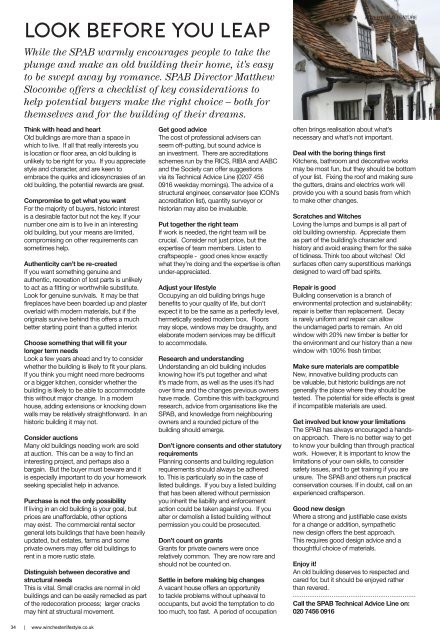Winchester Lifestyle Feb - Mar 2020
The Early Spring edition, featuring an interview with top chef Mitch Tonks, fabulous home inspiration, delicious recipes, travel to Santa Barbara and Victorian home renovations.
The Early Spring edition, featuring an interview with top chef Mitch Tonks, fabulous home inspiration, delicious recipes, travel to Santa Barbara and Victorian home renovations.
Create successful ePaper yourself
Turn your PDF publications into a flip-book with our unique Google optimized e-Paper software.
Look Before You Leap<br />
While the SPAB warmly encourages people to take the<br />
plunge and make an old building their home, it’s easy<br />
to be swept away by romance. SPAB Director Matthew<br />
Slocombe offers a checklist of key considerations to<br />
help potential buyers make the right choice – both for<br />
themselves and for the building of their dreams.<br />
Think with head and heart<br />
Old buildings are more than a space in<br />
which to live. If all that really interests you<br />
is location or floor area, an old building is<br />
unlikely to be right for you. If you appreciate<br />
style and character, and are keen to<br />
embrace the quirks and idiosyncrasies of an<br />
old building, the potential rewards are great.<br />
Compromise to get what you want<br />
For the majority of buyers, historic interest<br />
is a desirable factor but not the key. If your<br />
number one aim is to live in an interesting<br />
old building, but your means are limited,<br />
compromising on other requirements can<br />
sometimes help.<br />
Authenticity can’t be re-created<br />
If you want something genuine and<br />
authentic, recreation of lost parts is unlikely<br />
to act as a fitting or worthwhile substitute.<br />
Look for genuine survivals. It may be that<br />
fireplaces have been boarded up and plaster<br />
overlaid with modern materials, but if the<br />
originals survive behind this offers a much<br />
better starting point than a gutted interior.<br />
Choose something that will fit your<br />
longer term needs<br />
Look a few years ahead and try to consider<br />
whether the building is likely to fit your plans.<br />
If you think you might need more bedrooms<br />
or a bigger kitchen, consider whether the<br />
building is likely to be able to accommodate<br />
this without major change. In a modern<br />
house, adding extensions or knocking down<br />
walls may be relatively straightforward. In an<br />
historic building it may not.<br />
Consider auctions<br />
Many old buildings needing work are sold<br />
at auction. This can be a way to find an<br />
interesting project, and perhaps also a<br />
bargain. But the buyer must beware and it<br />
is especially important to do your homework<br />
seeking specialist help in advance.<br />
Purchase is not the only possibility<br />
If living in an old building is your goal, but<br />
prices are unaffordable, other options<br />
may exist. The commercial rental sector<br />
general lets buildings that have been heavily<br />
updated, but estates, farms and some<br />
private owners may offer old buildings to<br />
rent in a more rustic state.<br />
Distinguish between decorative and<br />
structural needs<br />
This is vital. Small cracks are normal in old<br />
buildings and can be easily remedied as part<br />
of the redecoration process; larger cracks<br />
may hint at structural movement.<br />
Get good advice<br />
The cost of professional advisers can<br />
seem off-putting, but sound advice is<br />
an investment. There are accreditations<br />
schemes run by the RICS, RIBA and AABC<br />
and the Society can offer suggestions<br />
via its Technical Advice Line (0207 456<br />
0916 weekday mornings). The advice of a<br />
structural engineer, conservator (see ICON’s<br />
accreditation list), quantity surveyor or<br />
historian may also be invaluable.<br />
Put together the right team<br />
If work is needed, the right team will be<br />
crucial. Consider not just price, but the<br />
expertise of team members. Listen to<br />
craftspeople - good ones know exactly<br />
what they’re doing and the expertise is often<br />
under-appreciated.<br />
Adjust your lifestyle<br />
Occupying an old building brings huge<br />
benefits to your quality of life, but don’t<br />
expect it to be the same as a perfectly level,<br />
hermetically sealed modern box. Floors<br />
may slope, windows may be draughty, and<br />
elaborate modern services may be difficult<br />
to accommodate.<br />
Research and understanding<br />
Understanding an old building includes<br />
knowing how it’s put together and what<br />
it’s made from, as well as the uses it’s had<br />
over time and the changes previous owners<br />
have made. Combine this with background<br />
research, advice from organisations like the<br />
SPAB, and knowledge from neighbouring<br />
owners and a rounded picture of the<br />
building should emerge.<br />
Don’t ignore consents and other statutory<br />
requirements<br />
Planning consents and building regulation<br />
requirements should always be adhered<br />
to. This is particularly so in the case of<br />
listed buildings. If you buy a listed building<br />
that has been altered without permission<br />
you inherit the liability and enforcement<br />
action could be taken against you. If you<br />
alter or demolish a listed building without<br />
permission you could be prosecuted.<br />
Don’t count on grants<br />
Grants for private owners were once<br />
relatively common. They are now rare and<br />
should not be counted on.<br />
Settle in before making big changes<br />
A vacant house offers an opportunity<br />
to tackle problems without upheaval to<br />
occupants, but avoid the temptation to do<br />
too much, too fast. A period of occupation<br />
ADVERTISING FEATURE<br />
often brings realisation about what’s<br />
necessary and what’s not important.<br />
Deal with the boring things first<br />
Kitchens, bathroom and decorative works<br />
may be most fun, but they should be bottom<br />
of your list. Fixing the roof and making sure<br />
the gutters, drains and electrics work will<br />
provide you with a sound basis from which<br />
to make other changes.<br />
Scratches and Witches<br />
Loving the lumps and bumps is all part of<br />
old building ownership. Appreciate them<br />
as part of the building’s character and<br />
history and avoid erasing them for the sake<br />
of tidiness. Think too about witches! Old<br />
surfaces often carry superstitious markings<br />
designed to ward off bad spirits.<br />
Repair is good<br />
Building conservation is a branch of<br />
environmental protection and sustainability:<br />
repair is better than replacement. Decay<br />
is rarely uniform and repair can allow<br />
the undamaged parts to remain. An old<br />
window with 20% new timber is better for<br />
the environment and our history than a new<br />
window with 100% fresh timber.<br />
Make sure materials are compatible<br />
New, innovative building products can<br />
be valuable, but historic buildings are not<br />
generally the place where they should be<br />
tested. The potential for side effects is great<br />
if incompatible materials are used.<br />
Get involved but know your limitations<br />
The SPAB has always encouraged a handson<br />
approach. There is no better way to get<br />
to know your building than through practical<br />
work. However, it is important to know the<br />
limitations of your own skills, to consider<br />
safety issues, and to get training if you are<br />
unsure. The SPAB and others run practical<br />
conservation courses. If in doubt, call on an<br />
experienced craftsperson.<br />
Good new design<br />
Where a strong and justifiable case exists<br />
for a change or addition, sympathetic<br />
new design offers the best approach.<br />
This requires good design advice and a<br />
thoughtful choice of materials.<br />
Enjoy it!<br />
An old building deserves to respected and<br />
cared for, but it should be enjoyed rather<br />
than revered.<br />
Call the SPAB Technical Advice Line on:<br />
020 7456 0916<br />
34 | www.winchesterlifestyle.co.uk


















